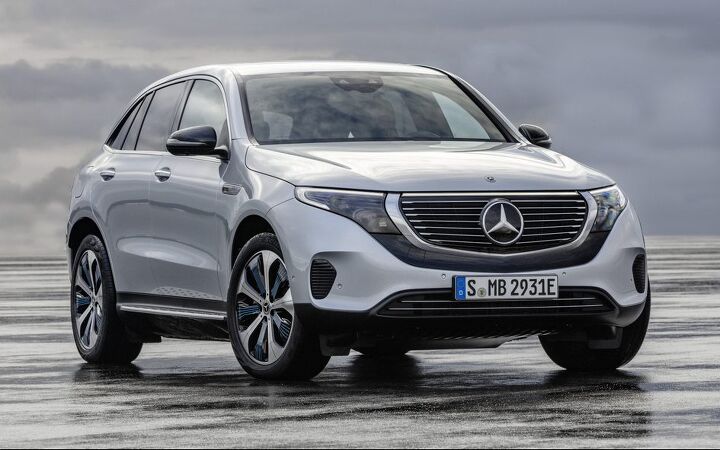Whoa, Hold on There: Mercedes-Benz EQC's Arrival Delayed

The first fully electric Mercedes-Benz, slated to arrive on these shores early next year, will instead spend 2020 backpacking around Europe.
Called the EQC, the conventionally-styled compact EV crossover is positioned to do battle with Jaguar’s I-Pace and Audi’s E-Tron — vehicles that garnered a tepid consumer response in the States, despite claims to the contrary by their respective builders. Mercedes-Benz isn’t saying the year-long delay has anything to do with that, however. It’s apparently all about serving Europeans better.
Word reached U.S. dealers on Friday, Automotive News reports. The anticipated delay is “at least” one year, which could mean Americans won’t see the EQC until late spring or perhaps even early summer, 2021.
“In a recent direction from Daimler AG, it is a strategic decision to first support the growing customer demand for the EQC in Europe,” the automaker told AN.
While the EPA hadn’t gotten around to testing the EQC, an early range estimate of around 200 miles left EV fans recoiling in horror before the automaker stepped in and called the figure an error. Converting European range figures to U.S. values is a tricky thing; the best guess we’ve seen out there is 222 miles. It’s unlikely the EPA would go higher. While that figure would pale in comparison to Jag’s I-Pace or Tesla’s Model X, it’s at least greater than the E-Tron’s lackluster 204-mile rating.
Powered by two electric motors drawing current from an 80 kWh battery pack, the EQC boasts a combined output of 402 horsepower, ensuring that the all-wheel drive CUV won’t be a slug on the highway. Still, news of the delay quickly sparked speculation that M-B’s motivation lay in waiting for U.S. consumer demand to pick up. If that’s true, the automaker isn’t talking.
European-based automakers must conform to increasingly stringent environmental mandates in that region; launching whole-hog EVs is seen as the quickest way to reduce fleetwide emissions. Given the proliferation of recharging infrastructure, shorter distances between cities, and higher fuel prices in that market, buyers appear vastly more willing to purchase an EV than their American counterparts.
When the EQC does arrive stateside, it will have a new competitor in the form of the equally conventional-looking BMW iX3 — an EV take on the brand’s standard X3 crossover. Porsche’s Macan will also drop its internal combustion clothes in 2021.
[Image: Daimler AG]

More by Steph Willems
Latest Car Reviews
Read moreLatest Product Reviews
Read moreRecent Comments
- Lorenzo I just noticed the 1954 Ford Customline V8 has the same exterior dimensions, but better legroom, shoulder room, hip room, a V8 engine, and a trunk lid. It sold, with Fordomatic, for $21,500, inflation adjusted.
- Lorenzo They won't be sold just in Beverly Hills - there's a Nieman-Marcus in nearly every big city. When they're finally junked, the transfer case will be first to be salvaged, since it'll be unused.
- Ltcmgm78 Just what we need to do: add more EVs that require a charging station! We own a Volt. We charge at home. We bought the Volt off-lease. We're retired and can do all our daily errands without burning any gasoline. For us this works, but we no longer have a work commute.
- Michael S6 Given the choice between the Hornet R/T and the Alfa, I'd pick an Uber.
- Michael S6 Nissan seems to be doing well at the low end of the market with their small cars and cuv. Competitiveness evaporates as you move up to larger size cars and suvs.



































Comments
Join the conversation
" It’s apparently all about serving Europeans better." Yeah, right, Europeans are so happy now. But in all seriousness - it should stay where it belongs and come here when it's ready.
@rocket +1 !